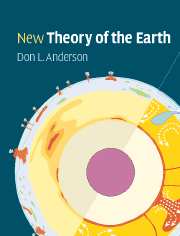Book contents
- Frontmatter
- Contents
- Preface and Philosophy
- Abbreviations and acronyms
- Part I Planetary perspective
- Part II Earth: the dynamic planet
- Part III Radial and lateral structure
- Part IV Sampling the Earth
- Part V Mineral physics
- Part VI Origin and evolution of the layers and blobs
- Part VII Energetics
- Chapter 26 Terrestrial heat flow
- Chapter 27 The thermal history of the Earth
- References and notes
- Appendix
- Index
Chapter 26 - Terrestrial heat flow
Published online by Cambridge University Press: 05 June 2012
- Frontmatter
- Contents
- Preface and Philosophy
- Abbreviations and acronyms
- Part I Planetary perspective
- Part II Earth: the dynamic planet
- Part III Radial and lateral structure
- Part IV Sampling the Earth
- Part V Mineral physics
- Part VI Origin and evolution of the layers and blobs
- Part VII Energetics
- Chapter 26 Terrestrial heat flow
- Chapter 27 The thermal history of the Earth
- References and notes
- Appendix
- Index
Summary
During the thirty-five years which have passed since I gave this wide-ranged estimate [of 20–400 million years] experimental investigation has supplied much of the knowledge then wanting regarding the thermal properties of rocks to form a closer estimate of the time which has passed since the consolidation of the earth, we have now good reason for judging that it was more than 20,000,000 and less than 40,000,000 years ago, and probably much nearer 20 than 40.
Lord KelvinHeat losses
The nature of the surface boundary condition of the mantle changes with time. Currently, the mantle has a conduction boundary layer with a thickness that averages 100–200 km. The boundary layer is assumed to start out at zero thickness at volcanic ridges; it is pierced in places by volcanoes that deliver a small fraction of the Earth's heat to the surface via magma, and it may be invaded at greater depths by sills and dikes that affect the bathymetry and heat flow. Ridges also jump around, migrate or start on a pre-existing TBL. The cooling of the mantle is mainly accomplished by the cooling of the surface plates. In early Earth history a transient magma ocean allowed magmas to transfer their heat directly to the atmosphere. As buoyant material collected at the top, the partially molten interior became isolated from the surface. Magma, however, could break through a possibly thick buoyant layer and create ‘heat pipes’ to carry magma and heat to the surface.
- Type
- Chapter
- Information
- New Theory of the Earth , pp. 333 - 348Publisher: Cambridge University PressPrint publication year: 2007



